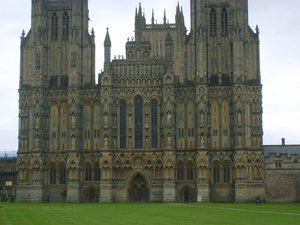Advertisement
Published: January 29th 2013

 S5000610
S5000610
The Wells CathedralToday, we visited Wells & Bath. In Wells, the famous Wells Cathedral was advised to visited. Bath is known about it Roman Baths. The old Romans build a whole temple complex around a geothermal spring. So, this day was full of (historical) culture.
Around 9 am we left with the bus to Wells. Wells, is the smallest city (not a town!) in England, but also famous about its Cathedral. This cathedral is ornate with 300 sculptress, whereas 150 of them are life-size. The building of this cathedral started in 1175. However, historians think that at the year of 705 another church stood on this place. And the entrance was free, however a photo permit was 3 pounds. We bought one.
Again, this cathedral was big, and similar "gothic" building. We took the stairs "Chapter House Steps" to the (surprise) "Chapter House", build in 1306. This chapter house was used for meetings. Again, there were a lot of grave tombs, and the flour was covered with tombstones. Some of those tombstones where really old. Also, at eleven, we stood by a clock, which clang. This church also had a lot of culture treasures. You also could enter a guided tour,

 S5000626
S5000626
Christian Art inside the Cathedralstarted at 11 am. Sadly, we dind't had much time to do this free tour. However, you really can spend easily 1-2 hours in this cathedral.
Then, we visited Bath. First we took a lunch by the Pizza hut (all-you-can-eat). You could choose between pizzas, pastas and salads.
First, we walked around in Bath, and visit the cathedral of Bath. Then we saw some musicians playing on the central square. Then, we entered the Roman Baths.
The Roman Baths were expensive to enter, but it is really worth your money. They found the baths in 1700. But not only the bad, they still find temple ruins or archeological treasures in this area. Because the temples were very close to the bath, they made a museum of the bath and the temple ruins, of course with all the archeological findings. This museum was included by the entrance money. The Romans found a geothermal spring. The water is pumped from a depth of 2,7 km (!!) above. Due the high pressure, the water is pressed out of the stones. The spring had a temperature between 64-96 degrees (Celsius). The Romans build some baths around it, and also some temples.

 S5000684
S5000684
"The Roman Bath House". (The Roman Baths)They believed the water had a healing function. It was well-known in the Roman Empire; sick people all over the Empire came to Bath to heal themselves with the water. The Romans made water pipes to transport the water to their baths. They even had special baths for people which came for the healing function. You also could see the spring itself, it's called the "Sacred Spring". The water had a yellow-gold color, because of the iron and calc state of the water. You saw the water coming out of the rocks and with it, a lot of water damp. You also could see the old water pipes, which the old Roman build. We also visited the "Roman Bath House", which was the public, big bath. However it was not advised to touch the water, we did (a lot of people did). And indeed, the water was nicely warm. I really can understand why the Romans loved this bath, it really had a very good temperature. Also, you could see the temple ruins. Beautiful. They even found some hand written papers. The Romans believed that, if you put a paper in the bath of a criminal the Gods would punish

 S5000700
S5000700
Bath ruines inside the Roman Bathsthem, for example thieves. You really could see this papers. Some were still in very good state; you had to look good but you saw some writings! Awesome! Also, you could visit the baths, often as temple ruin made for the people who came for the healing. And there were a lot of archaeological founds in the museum.
Bath was really a nice city to visit. I really should advice to visit the Roman Baths, it’s really worth your money. If you plan your visit, you really can spend more then 2-3 hours inside, so you should take a lot of time, especially when you love archeology. Also, it’s nice for the kids; there are some children attractions: for example a game how the Romans build the temples. I agree it was even nicer than Stonehenge.
Then, we went back to our hotel, diner was waiting. As starter I choose vegetable soup. However, when served it was brown, similar to my mother’s brown kidney bean soup, however not bad. As main we got potatoes (still in its sin), with two (!) pork bellies and 1 rose broccoli + 1 rose cauliflower. You really could see that the broccoli

 S5000687
S5000687
A model of the Roman bath-temple complex, made by historians was a little bit old; it started to discolor (became a little bit brown). Well, I should not complain. As dessert I had cream puffs with chocolate sauce.
That night we visited the pub again. The Abbot Ale, my favorite beer, was back in stock! Yeah! After some drinks we went back to our room. Tomorrow, another day!
Advertisement
Tot: 0.13s; Tpl: 0.011s; cc: 13; qc: 62; dbt: 0.0795s; 1; m:domysql w:travelblog (10.17.0.13); sld: 1;
; mem: 1.2mb












